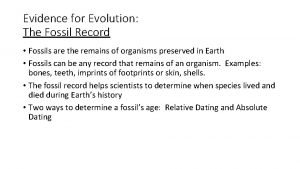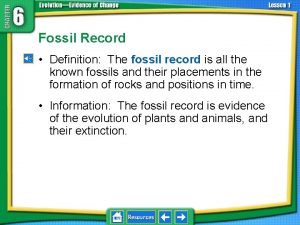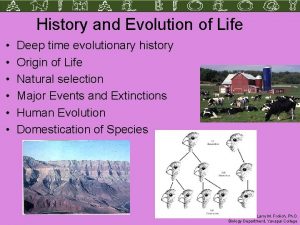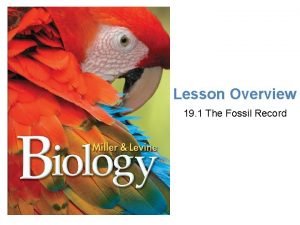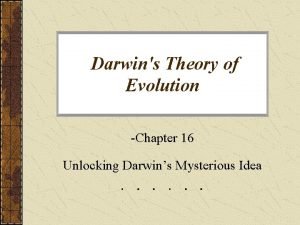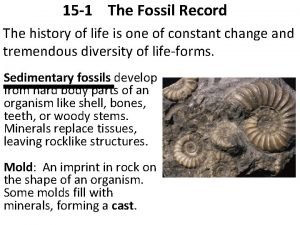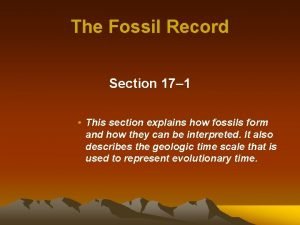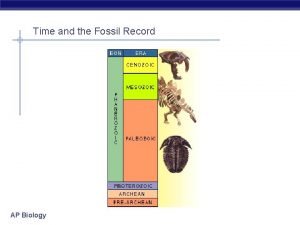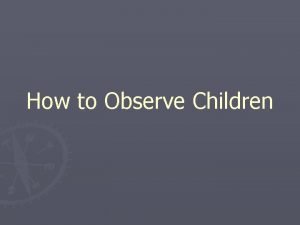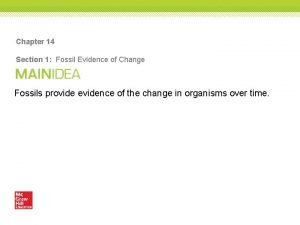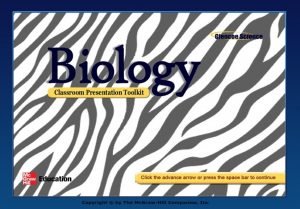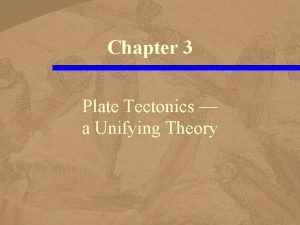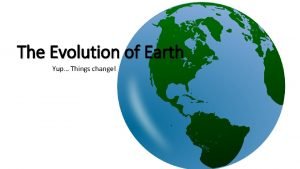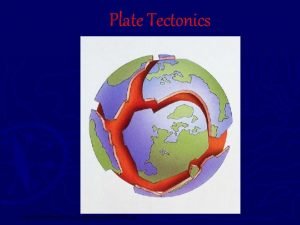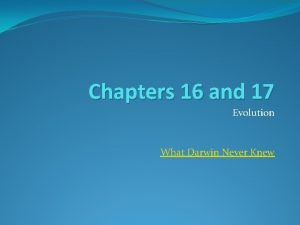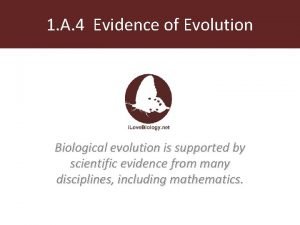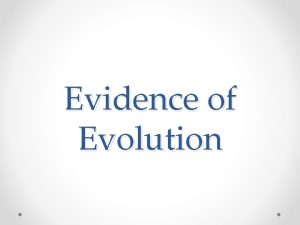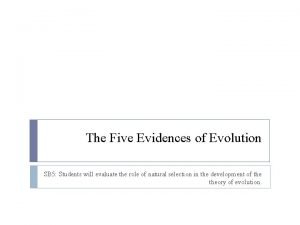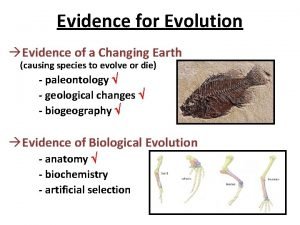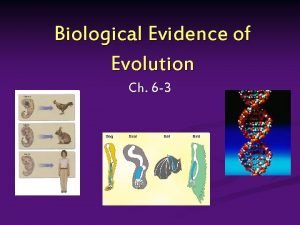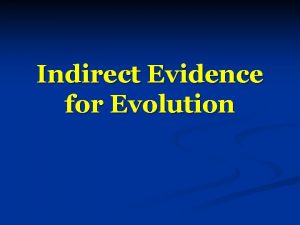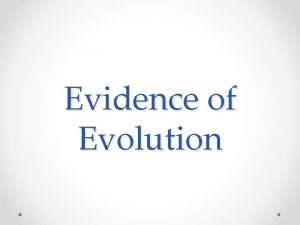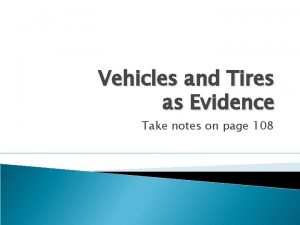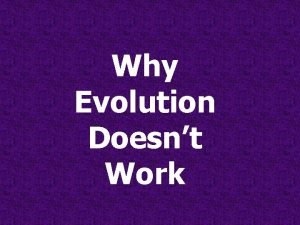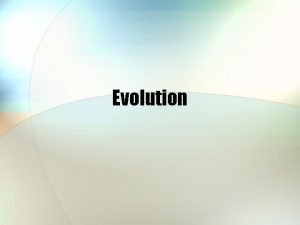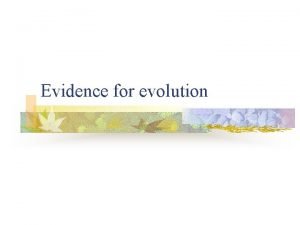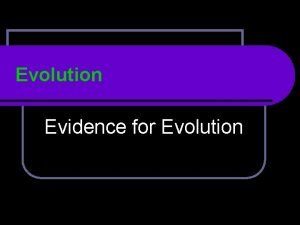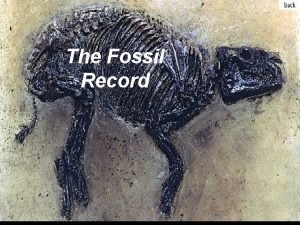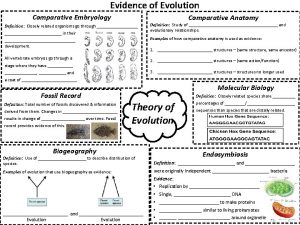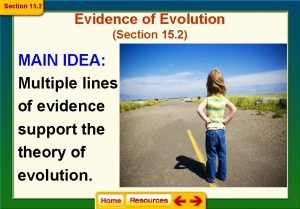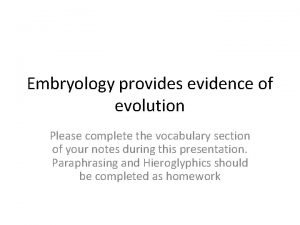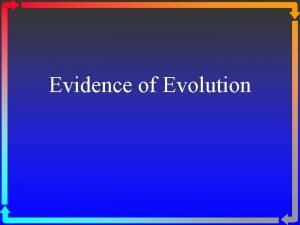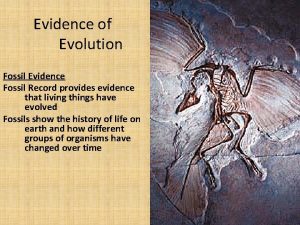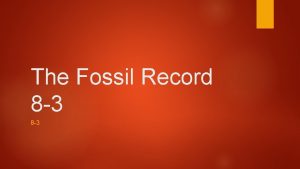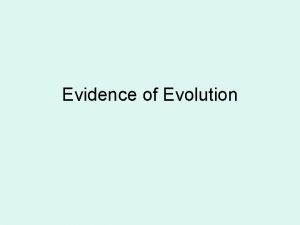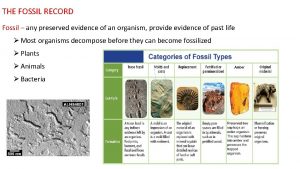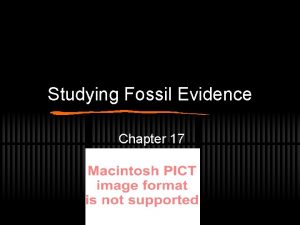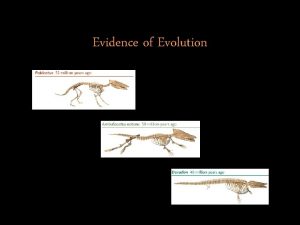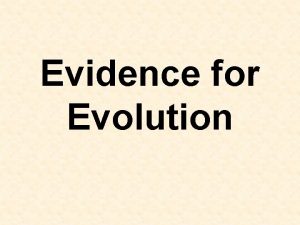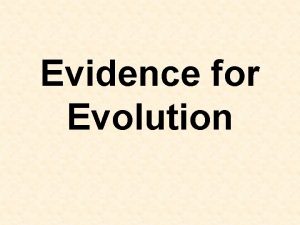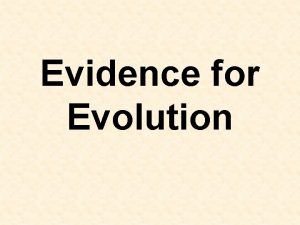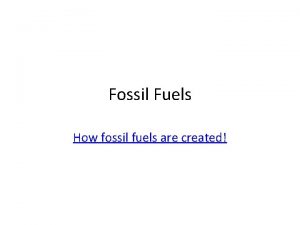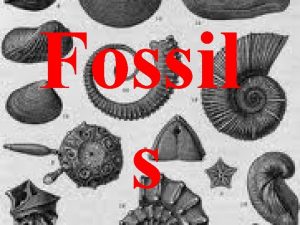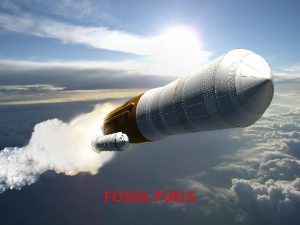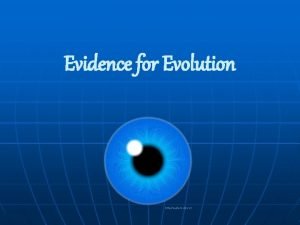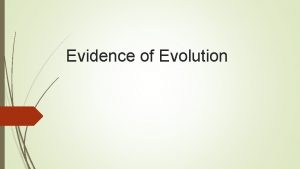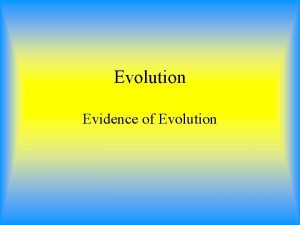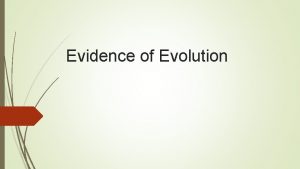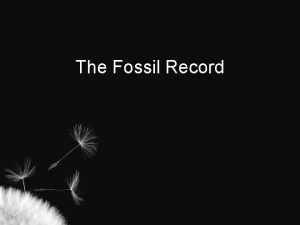Evidence for Evolution Evidence 1 The Fossil Record

































- Slides: 33

Evidence for Evolution

Evidence # 1 – The Fossil Record The most abundant evidence for evolution comes from fossils that have been found all over the world. Fossils are any remains of life from an earlier time.

Examples of Fossils 1. The imprint of a leaf, feather, or organism in a rock.

Examples of Fossils 2. A cast made of minerals that filled in the hollows of an animal track, mollusk shell, or other parts of an organism.

Examples of Fossils 3. A piece of wood or bone replaced by minerals

Examples of Fossils 4. An organism frozen in ice

Examples of Fossils 5. An insect or other organism trapped in plant resin. Example: mosquitoes in amber, like in the movie Jurassic Park.

Evidence #1 – The Fossil Record Sedimentary rock contains the most fossils. Sedimentary rock is a rock type formed by mud, sand, or other fine particles that settle out of a liquid (like water). Limestone, sandstone, and shale are all examples of sedimentary rock. Fossils are found more often in limestone than in any other kind of sedimentary rock.

Evidence #1 – The Fossil Record To figure our the age of a fossil, scientists have a couple of different methods. Scientists have divided Earth’s history up into eras and periods. These divisions make up the geologic time scale.

Evidence #1 – The Fossil Record Unique rock layers and fossils give information about the geology, climate, and life forms of each time period. There are two (2) basic methods for reading the record of past life. When these two methods are used together, accurate estimates of the ages of certain rocks and fossils are made.

Evidence #1 – The Fossil Record Relative Dating One method often used to figure out the approximate age of a rock layer, or fossils within the layer is to look where the particular rock layer is. In undisturbed areas, older rock layers lie below successively younger rock layers.

Evidence #1 – The Fossil Record Fossils found in the lowest layers of rock are older than those in upper layers. This method of dating fossils is known as relative dating. Relative dating can only estimate the age of a fossil.

Evidence #1 – The Fossil Record Radioactive Dating A method used to give a more accurate age to a rock layer or fossil is dating using radioactive elements. Radioactive elements give off radiation, a form of atomic energy.

Evidence #1 – The Fossil Record Uranium and a radioactive form of carbon are used in radioactive dating. Radioactive elements change to more stable products as they give off radiation. The radiation is given off at a constant rate, and the rate is different for each element.

Evidence #1 – The Fossil Record Scientists can measure how much of a radioactive element has changed. They can accurately tell the age of the rock by comparing the amount of stable product with the amount of radioactive element still present.

Evidence #1 – The Fossil Record For example, the radioactive element uranium changes to lead as it ages. Scientists can determine how old a fossil in a rock sample is by measuring the amounts of uranium and lead in the rock. The more lead there is, the older the rock, and by association, the older the fossil.

Evidence #1 – The Fossil Record Fossils are a record of organisms that lived in the past. But the fossil record is incomplete, much like a book with some pages missing. Because every living thing doesn’t or can’t become fossilized, the record will never be complete.

Evidence #1 – The Fossil Record By looking at fossils, scientists have figured out that many simpler forms of life existed earlier in Earth’s history, and more complex forms appear later.

Evidence #1 – The Fossil Record The oldest fossil bacteria appeared 3. 8 billion years ago. Simple invertebrates appeared in the Cambrian period, about 540 million years ago. The first land plants did not appear until the Silurian period, 438 million years ago.

Evidence #1 – The Fossil Record Dinosaurs ruled the Earth during the Triassic and Jurassic periods, from 208 to 144 million years ago. The first mammals and birds did not appear until the Jurassic period, about 200 million years ago. The fossil record gives scientists convincing evidence that living things evolved.


Evidence #2 – Homologous Structures You know that the functions of your arm, a dolphin’s flipper, a bat’s wing, and a bird’s wing are all very different. Yet, as you will see, each of the structures is made up of the same kind of bones. Each has about the same number of muscles and blood vessels.


Evidence #2 – Homologous Structures Each of these limbs developed from similar tissues in the embryo. Body parts that are similar in origin and structure are called homologous. Homologous structures give evidence that two or more species shared common ancestors.

Evidence #3 – Vestigial Structures Vestigial structures also give evidence for evolution. A vestigial structure is a body part that is smaller in size and doesn’t seem to have a function.

Evidence #3 – Vestigial Structures Examples of the vestigial organs in humans are the appendix and the muscles that move the ear. Whales no longer have back legs, but they still have the bones of the pelvis. Scientists think vestigial structures are parts that once functioned in an ancestor.

Evidence #4 - Embryology The study of the development of embryos is called embryology. An embryo is an organism in its earliest stages of development.

Evidence #4 – Embryology

Evidence #4 - Embryology In the early stages of development, the embryos of fish, reptiles, birds, and mammals have a tail and gills or gill slits. Fish keep their gills, but the other organisms lose them as their development continues. In humans, the tail disappears, but fish, birds, and lizards keep their tails.

Evidence #4 - Embryology These similarities suggest that all vertebrate animals (animals with a backbone) are related. This supports evidence from the fossil record that shows aquatic, gillbreathing organisms evolved before air -breathing land vertebrates.

Evidence #5 - DNA is the molecule that controls heredity. Scientists can determine whether or not organisms are closely related by comparing their DNA. Organisms that are close relatives have similar DNA.

Evidence #5 - DNA By studying DNA, scientists have determined dogs are the closest relatives to bears. You would probably not be surprised to learn that gorillas and chimpanzees also have similar DNA. Genetic evidence also supports the view that primates all came from a common ancestor.

Evidence #5 - DNA changes over time due to mutations. B A Organisms A and B are closely related. DNA hasn’t had much time to change or mutate. The DNA of organisms A and B will still be similar. Organisms B and C are distant relatives. A lot of time has passed since they shared a C common ancestor. The DNA has had more time to change/mutate.
 How are fossils evidence for evolution
How are fossils evidence for evolution Vestigial structures defintion
Vestigial structures defintion Fossil record
Fossil record What is the “fossil record”?
What is the “fossil record”? Darwin viewed the fossil record as
Darwin viewed the fossil record as Section 15-1 review the fossil record
Section 15-1 review the fossil record Section 17-1 the fossil record
Section 17-1 the fossil record Fossil record definition biology
Fossil record definition biology Specimen record observation
Specimen record observation Chapter 14 study guide section 1 fossil evidence of change
Chapter 14 study guide section 1 fossil evidence of change The history of life section 1 fossil evidence of change
The history of life section 1 fossil evidence of change Fossil and mountain chain evidence
Fossil and mountain chain evidence Pangea fossil evidence
Pangea fossil evidence Pangea fossil evidence
Pangea fossil evidence Charles darwin
Charles darwin Evidence for evolution
Evidence for evolution Analogous structures
Analogous structures Five evidences of evolution
Five evidences of evolution Lamarck theory of evolution
Lamarck theory of evolution Bottleneck effect
Bottleneck effect 6 evidences of evolution
6 evidences of evolution Indirect evidence of evolution
Indirect evidence of evolution What are the 4 types of evidence
What are the 4 types of evidence Evidence for evolution doodle notes
Evidence for evolution doodle notes Evidence of evolution
Evidence of evolution Embryological evidence of evolution
Embryological evidence of evolution Embryology evidence of evolution
Embryology evidence of evolution Embryology evidence
Embryology evidence Evidence of evolution of remnants and impressions *
Evidence of evolution of remnants and impressions * Comparative embryology definition
Comparative embryology definition Section 15-2 review theories of evolution
Section 15-2 review theories of evolution Evidence for evolution
Evidence for evolution What is evolution
What is evolution What are the 4 types of evidence for evolution
What are the 4 types of evidence for evolution
